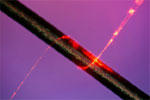. 2005. “Nanowiring Light.” In . Optical Fiber Communication Conference 2005. Publisher's VersionAbstract
Silica nanowires
. 2005. “Waveguide bends from nanometric silica wires.” In . Nanophotonics, Nanostructure, and Nanometrology. Publisher's VersionAbstract
. 2003. “Subwavelength-diameter silica wires for low-loss optical wave guiding.” Nature, 426, Pp. 816–819. Publisher's VersionAbstract
. 2007. “High Order Waveguide Modes in ZnO Nanowires.” Nanoletters, 7, Pp. 3675–3680. Publisher's VersionAbstract
. 2002. “Submicron and nano-diameter silica wires for optical wave guiding.” In . Proceedings of the Asia-Pacific Optical and Wireless Communications 2002 SPIE Meeting. Publisher's VersionAbstract
. 2005. “Subwavelength-diameter silica wires for microscale optical components.” In . SPIE Photonics West 2005. Publisher's VersionAbstract
. 2006. “Supercontinuum generation in submicrometer diameter silica fibers.” Opt. Exp., 14, Pp. 9408–9414. Publisher's VersionAbstract
. 2005. “Modeling of subwavelength-diameter optical wire waveguides for optical sensing applications.” In . Advanced Sensor Systems and Applications II. Publisher's VersionAbstract
. 2008. “Glass nanofibers for micro- and nano-scale photonic devices.” J. Non-Crystalline Solids, 354, Pp. 1240–1244. Publisher's VersionAbstract
 We developed a process for fabricating silica nanowires with a diameter of only one thousandth the diameter of a hair. Although significantly narrower than the wavelength of light, these nanowires can act as "rails" for light and are promising building blocks for future microphotonic devices.
We developed a process for fabricating silica nanowires with a diameter of only one thousandth the diameter of a hair. Although significantly narrower than the wavelength of light, these nanowires can act as "rails" for light and are promising building blocks for future microphotonic devices.